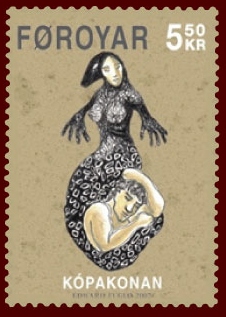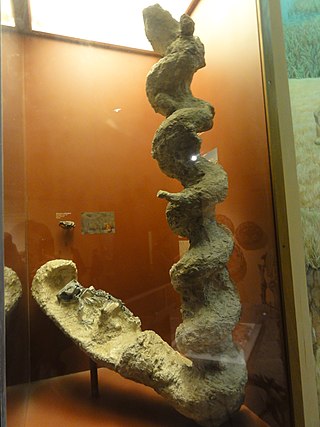Related Research Articles

A fairy tale is a short story that belongs to the folklore genre. Such stories typically feature magic, enchantments, and mythical or fanciful beings. In most cultures, there is no clear line separating myth from folk or fairy tale; all these together form the literature of preliterate societies. Fairy tales may be distinguished from other folk narratives such as legends and explicit moral tales, including beast fables. Prevalent elements include dwarfs, dragons, elves, fairies, giants, gnomes, goblins, griffins, mermaids, talking animals, trolls, unicorns, monsters, witches, wizards, and magic and enchantments.

A fairy is a type of mythical being or legendary creature found in the folklore of multiple European cultures, a form of spirit, often described as metaphysical, supernatural, or preternatural.

The figure of Mother Goose is the imaginary author of a collection of French fairy tales and later of English nursery rhymes. As a character, she appeared in a song, the first stanza of which often functions now as a nursery rhyme. This, however, was dependent on a Christmas pantomime, a successor to which is still performed in the United Kingdom.
Fairies, particularly those of Irish, English, Scottish and Welsh folklore, have been classified in a variety of ways. Classifications – which most often come from scholarly analysis, and may not always accurately reflect local traditions – typically focus on behavior or physical characteristics.

English folklore consists of the myths and legends of England, including the English region's mythical creatures, traditional recipes, urban legends, proverbs, superstitions, and folktales. Its cultural history is rooted in Celtic, Christian, and Germanic folklore.

In Celtic and Norse mythology, selkies or selkie folk meaning 'seal folk' are mythological beings capable of therianthropy, changing from seal to human form by shedding their skin. They are found in folktales and mythology originating from the Northern Isles of Scotland.

The Tar-Baby is the second of the Uncle Remus stories published in 1881; it is about a doll made of tar and turpentine used by the villainous Br'er Fox to entrap Br'er Rabbit. The more that Br'er Rabbit fights the Tar-Baby, the more entangled he becomes.

A werecat is an analog to "werewolf" for a feline therianthropic creature.

The Kaibab Limestone is a resistant cliff-forming, Permian geologic formation that crops out across the U.S. states of northern Arizona, southern Utah, east central Nevada and southeast California. It is also known as the Kaibab Formation in Arizona, Nevada, and Utah. The Kaibab Limestone forms the rim of the Grand Canyon. In the Big Maria Mountains, California, the Kaibab Limestone is highly metamorphosed and known as the Kaibab Marble.

Jean de l'Ours or John the Bear, John of the Bear, John-of-the-Bear, John Bear, is the leading character in the French folktale Jean de l'Ours classed as Type 301B in the Aarne–Thompson system; it can also denote any tale of this type.

Palaeocastor is an extinct genus of beavers that lived in the North American Badlands during the late Oligocene period to early Miocene. Palaeocastor was much smaller than modern beavers. There are several species including Palaeocastor fossor, Palaeocastor magnus,Palaeocastor wahlerti, and Palaeocastor peninsulatus.

The black dog is a supernatural, spectral, or demonic entity originating from English folklore that has also been seen throughout Europe and the Americas. It is usually unnaturally large with glowing red or yellow eyes, is often connected with the Devil, and is sometimes an omen of death. It is sometimes associated with electrical storms, and also with crossroads, barrows, places of execution and ancient pathways.

Cornish mythology is the folk tradition and mythology of the Cornish people. It consists partly of folk traditions developed in Cornwall and partly of traditions developed by Britons elsewhere before the end of the first millennium, often shared with those of the Breton and Welsh peoples. Some of this contains remnants of the mythology of pre-Christian Britain.
Paleontology or palaeontology is the study of prehistoric life forms on Earth through the examination of plant and animal fossils. This includes the study of body fossils, tracks (ichnites), burrows, cast-off parts, fossilised feces (coprolites), palynomorphs and chemical residues. Because humans have encountered fossils for millennia, paleontology has a long history both before and after becoming formalized as a science. This article records significant discoveries and events related to paleontology that occurred or were published in the year 1877.

Paleontology in Colorado refers to paleontological research occurring within or conducted by people from the U.S. state of Colorado. The geologic column of Colorado spans about one third of Earth's history. Fossils can be found almost everywhere in the state but are not evenly distributed among all the ages of the state's rocks. During the early Paleozoic, Colorado was covered by a warm shallow sea that would come to be home to creatures like brachiopods, conodonts, ostracoderms, sharks and trilobites. This sea withdrew from the state between the Silurian and early Devonian leaving a gap in the local rock record. It returned during the Carboniferous. Areas of the state not submerged were richly vegetated and inhabited by amphibians that left behind footprints that would later fossilize. During the Permian, the sea withdrew and alluvial fans and sand dunes spread across the state. Many trace fossils are known from these deposits.

Paleontology in New Mexico refers to paleontological research occurring within or conducted by people from the U.S. state of New Mexico. The fossil record of New Mexico is exceptionally complete and spans almost the entire stratigraphic column. More than 3,300 different kinds of fossil organisms have been found in the state. Of these more than 700 of these were new to science and more than 100 of those were type species for new genera. During the early Paleozoic, southern and western New Mexico were submerged by a warm shallow sea that would come to be home to creatures including brachiopods, bryozoans, cartilaginous fishes, corals, graptolites, nautiloids, placoderms, and trilobites. During the Ordovician the state was home to algal reefs up to 300 feet high. During the Carboniferous, a richly vegetated island chain emerged from the local sea. Coral reefs formed in the state's seas while terrestrial regions of the state dried and were home to sand dunes. Local wildlife included Edaphosaurus, Ophiacodon, and Sphenacodon.

Paleontology in Arizona refers to paleontological research occurring within or conducted by people from the U.S. state of Arizona. The fossil record of Arizona dates to the Precambrian. During the Precambrian, Arizona was home to a shallow sea which was home to jellyfish and stromatolite-forming bacteria. This sea was still in place during the Cambrian period of the Paleozoic era and was home to brachiopods and trilobites, but it withdrew during the Ordovician and Silurian. The sea returned during the Devonian and was home to brachiopods, corals, and fishes. Sea levels began to rise and fall during the Carboniferous, leaving most of the state a richly vegetated coastal plain during the low spells. During the Permian, Arizona was richly vegetated but was submerged by seawater late in the period.

The San Jose Formation is an Early Eocene geologic formation in the San Juan Basin of New Mexico and Colorado.
Urikohime, Uriko-hime or Uriko Hime is a Japanese folktale about a girl that is born out of a melon, adopted by a family and replaced by a creature named Amanojaku.
Augerinoichnus is a Permian trace fossil that has been found in New Mexico, US.
References
- 1 2 3 Carol Rose, Giants, Monsters, and Dragons: An Encyclopedia of Folklore, Legend and Myth. Norton, 2001, pp. 30-31. (Google Books link)
- ↑ Ernest W. Baughman, Type and Motif-Index of the Folktales of England and North America. Walter De Gruyter, 1966, p. 534. (Google Books link)
- 1 2 3 Ronald L. Ives, "Folklore of Eastern Middle Park, Colorado". Journal of American Folklore 54 (1941), pp. 24-43, at pp. 29-30.
- ↑ Ronald L. Ives, "The Augerino Oil Company". Coronet (Chicago), June 1938, pp. 53-57.
- ↑ Nicholas J. Minter et al. "Augerinoichnus Helicoidalis, a New Helical Trace Fossil from the Nonmarine Permian of New Mexico". Journal of Paleontology 82:6 (2008), pp. 1201-1206.